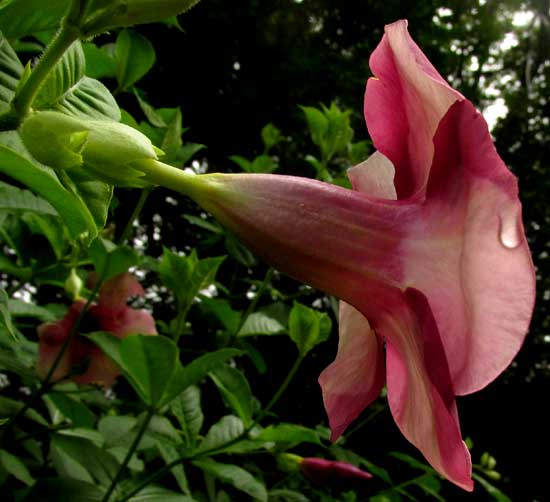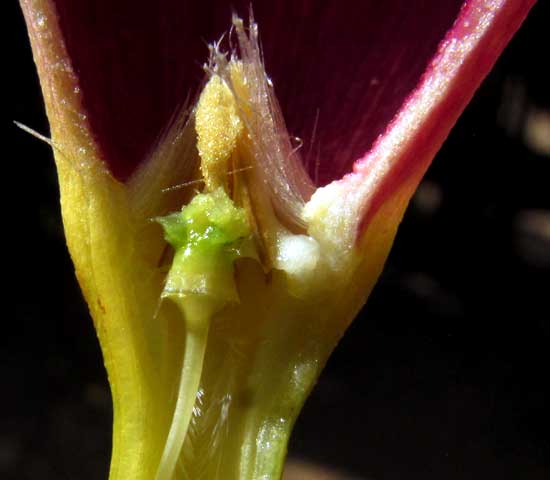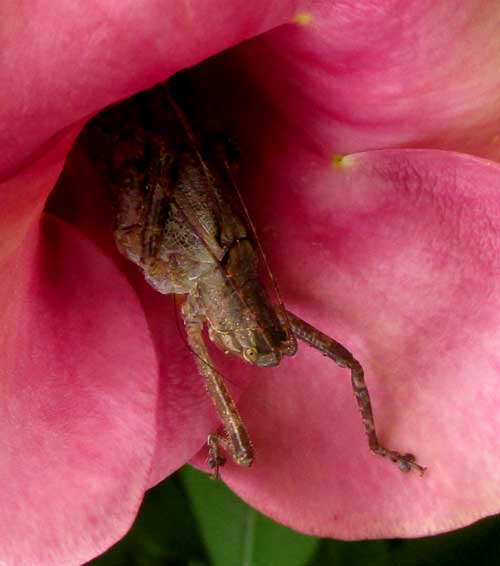Excerpts from Jim Conrad's
Naturalist Newsletter
from the August 16, 2018 Newsletter issued from Rancho Regenesis in the woods ±4kms west of Ek Balam Ruins; elevation ~40m (~130 ft), N~20.876°, W~88.170°; central Yucatán, MÉXICO
PURPLE ALLAMANDA FLOWERING
So far I've not mentioned the Purple Allamanda, ALLAMANDA VIOLACEA. It's a case of this very pretty ornamental species originally from Brazil being planted so commonly that I've been assuming that already I'd mentioned it. Below, you can see the three-inch-long (7.5cm), funnel-shaped blooms that make the species so desirable:

Below, a side view of a blossom shows how the corolla's slender base rises from an inflated calyx, then the corolla tube expands, and finally the broad corolla lobes flare outward:

A front view of the flower shows that the corolla tube darkens inside, then in the center at the very base displays a perfect little yellow star, as seen below:

Allamandas belong to the Dogbane/Milkweed/Oleander Family, the Apocynaceae, so the arrangement of the flowers' sexual parts are very different from most blossoms, and distinctive, as seen below:

The greenish part in the image's center is the stigma head. The yellow item above that is one of a few nearly stalkless, pollen-shedding anthers, and above that are long, stiff, sharp-pointed hairs directed upward. Pollinators entering the flower pass between tufts of these hairs. Notice that at the image's bottom, the hairs are pointing downward, encouraging pollinators to stay inside the blossom longer, thus more certainly accomplish their pollination task.
The Purple Allamanda's leaves are in twos or, more frequently, fours, as shown below:

Many blossoms droop downward, and that's handy for insects wanting to escape the rain, or hide. I found most of our plant's blossoms occupied by some kind of invertebrate, mostly small ones, but some fair sized ones, such as the katydid shown below:

Below, a cricket seems to be entering his place of worship:

Our profusely branched Purple Allamanda stands about 12ft tall (3.7m) and is shaped like an upside-down feather duster. Later in the year, if the rancho's ground crew don't prune it, it'll be spherical in shape, looking like a huge scoop of strawberry ice cream. If the plant were never pruned, it would behave more like a vine or bushy vine, and would send slender stems up into surrounding trees, not twining among their branches like a morning-glory, just supporting itself on whatever comes handy. It's a good candidate to cover an arbor, or to cascade over a wall, or even to make a large hanging basket.
Several cultivars have been developed of Purple Allamanda.
You may be interested in comparing our Purple Allamanda with the closely related Golden Trumpet vine, Allamanda cathartica, also commonly planted in these parts, whose page is at www.backyardnature.net/yucatan/allamand.htm